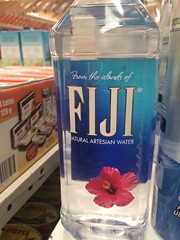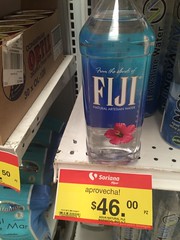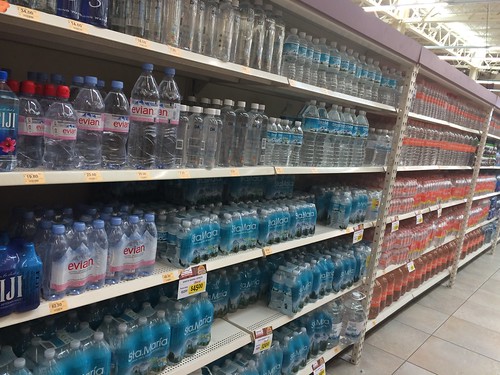 For my research on the politics of bottled water, I have been doing a lot of reading across different disciplines, from public health to environmental engineering, but I always come back to the excellent work of anthropologist Martha Kaplan. Professor Kaplan is at Vassar College and has done extensive work on bottled water, the local-global nexus and the nexus between rising consumption of bottled water and reduced usage of drinking water fountains. Professor Kaplan has looked at how different cultures value water and what these valuation processes look like in terms of strategies to engage with the worrisome global trend of growing consumption of bottled water. I have been thoroughly enthralled by the work of Professor Kaplan, and I find myself particularly fascinated with the ways in which she explores the global and local elements of bottled water consumption.
For my research on the politics of bottled water, I have been doing a lot of reading across different disciplines, from public health to environmental engineering, but I always come back to the excellent work of anthropologist Martha Kaplan. Professor Kaplan is at Vassar College and has done extensive work on bottled water, the local-global nexus and the nexus between rising consumption of bottled water and reduced usage of drinking water fountains. Professor Kaplan has looked at how different cultures value water and what these valuation processes look like in terms of strategies to engage with the worrisome global trend of growing consumption of bottled water. I have been thoroughly enthralled by the work of Professor Kaplan, and I find myself particularly fascinated with the ways in which she explores the global and local elements of bottled water consumption.
 I find myself weirded out by the sale of Fiji water anywhere in the world, but especially in a country like Mexico, where per capita bottled water consumption has risen to the point where Mexico is now the global leader. Obviously, packaging and selling the vital liquid in plastic bottles is big business in Mexico, and there is a clear interest on the part of transnational corporations in maintaining their market dominance. For me, it’s even more jarring that we effectively IMPORT bottled water given its price (a small bottle costs 46 Mexican pesos, which is about 2 dollars given the fast fall of the Mexican currency vis-a-vis the US dollar). This is one of the reasons why I find Professor Kaplan’s work on the transnational life of Fiji bottled water so fascinating.
I find myself weirded out by the sale of Fiji water anywhere in the world, but especially in a country like Mexico, where per capita bottled water consumption has risen to the point where Mexico is now the global leader. Obviously, packaging and selling the vital liquid in plastic bottles is big business in Mexico, and there is a clear interest on the part of transnational corporations in maintaining their market dominance. For me, it’s even more jarring that we effectively IMPORT bottled water given its price (a small bottle costs 46 Mexican pesos, which is about 2 dollars given the fast fall of the Mexican currency vis-a-vis the US dollar). This is one of the reasons why I find Professor Kaplan’s work on the transnational life of Fiji bottled water so fascinating.
Admittedly, Professor Kaplan assigns non-human agency to water itself (which I find slightly weird). Anybody who knows my work will know that I am not really well versed in, nor fond of, the material culture, actor-network theory literature. Nevertheless. I find Kaplan’s writing extraordinarily compelling and insightful, and I draw important lessons from her research for my own. I am particularly engaged with her piece writing a transnational biography of Fiji bottled water (using New York City as one of the locations for her analysis).
$2 USD may seem like a small price for a bottle of water, but given how much it actually really costs and the huge profit margin that bottling companies gain from extracting and packaging the liquid, I remain puzzled that some people in Mexico actually buy Fiji water. I am well aware of how consuming certain brands of bottled water may be seen as a status symbol (“for show off”) but paying $46 Mexican pesos just to look good consuming Fiji water seems a bit irrational and the price tag, a tad too steep.
I have previously written on how the mere existence of the bottled water industry means that we are effectively commodifying the human right to water. But nobody is really exempt from consuming bottled water anywhere in the world. Even in countries and cities where tap water is extraordinarily safe (like the case of Vancouver), I witnessed and documented an increase in consumption since 2009. One of the main reasons for the growth in bottled water consumption is a fear of the tap, as the recent Flint (Michigan, USA) case showed. Other reasons include structural barriers to encouraging tap water consumption, such as the lack of widely available public water fountains in public spaces, and the absence of refilling stations in malls, schools and other areas. These stations can be used by individuals to transport water across in portable bottles.
I have also argued before that ensuring and enacting the human right to water would signify the end of the global bottled water industry. Quite obviously, this may not sit well with the transnational corporations whose big business is packaging the scarce and vital liquid to profit from its sale and consumption. Moreover, these multinational enterprises are able to sustain dominance over domestic markets with the introduction of locally-producing water-packaging branches. These facilities produce at the local level, but their profits benefit the global company.
This dialogue between the global and the local is quite well described by Kaplan’s discussion of the consumption of Fiji bottled water in New York City:
“The politics of bottled water in both Fiji and the United States involve tense, interesting confrontations about public and private interests, legacies and opportunities, profit and meaning. It is not a simple story of Fijian noncapitalist purity and Western depredation. When it comes to water, like all commodities actually, neither demand nor supply are given, and how they relate to each other is something historically made in a dialogical process.”
Kaplan’s viewpoint is very well taken, and resonates with my own work. As I’ve argued elsewhere, understanding the politics of bottled water necessitates a dialogue between the local and the global. We need to broaden our understanding of how domestic consumption patterns are entangled with global economic forces and driven by policy failures as well as domestic political climates that encourage commodification of a human right rather than working together to solve local water utility problems through innovative delivery models. We need to work on understanding why Fiji water is perceived as “pure” whereas other brands may not enjoy this high status. Kaplan’s work helps understand how this phenomenon occurs as she finds that consumption of Fiji bottled water is not only acceptable but also encouraged in highly commodifying contexts (such as cities where status is perceived as an important individual quality – New York City, for example).


0 Responses
Stay in touch with the conversation, subscribe to the RSS feed for comments on this post.